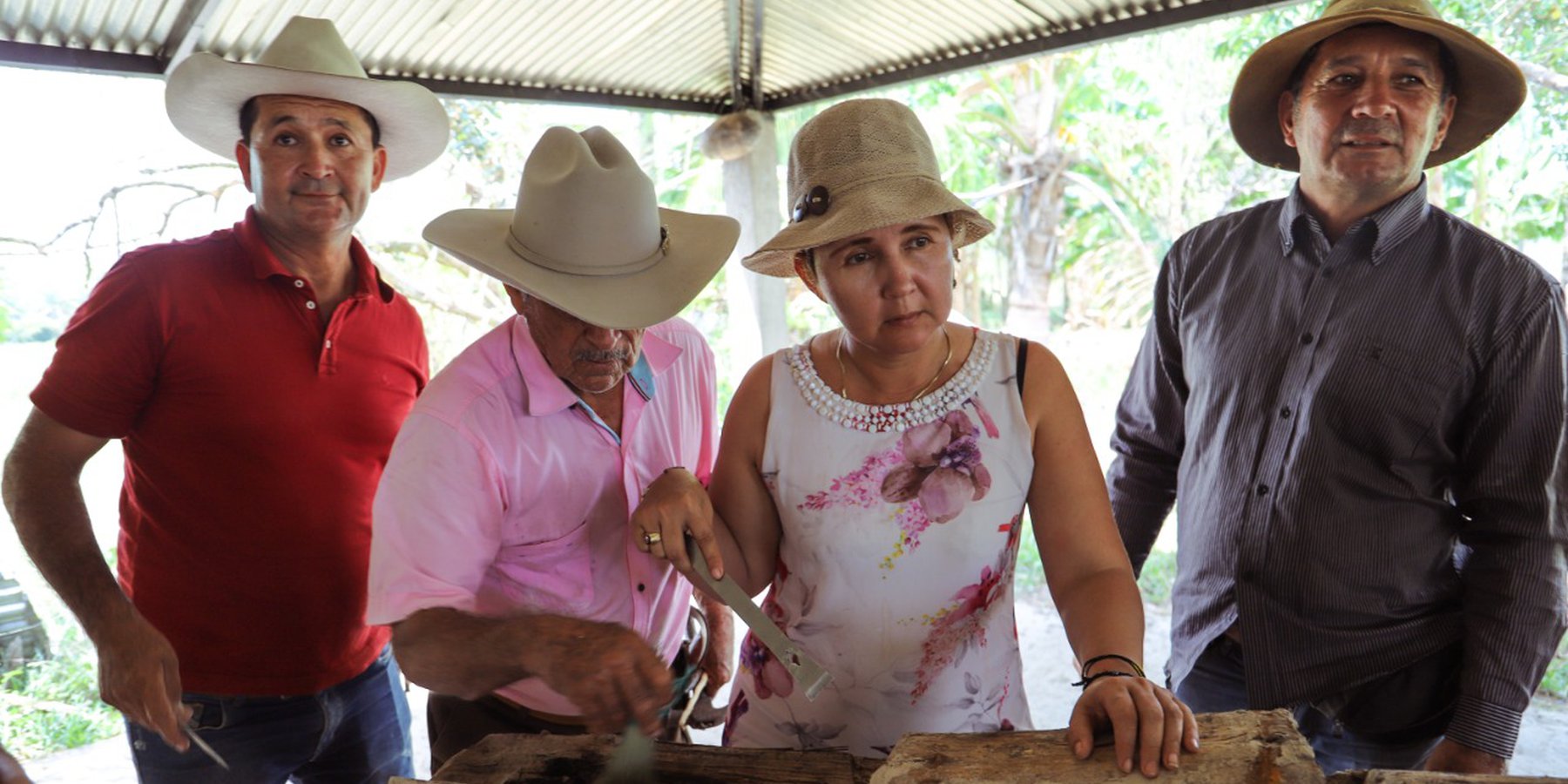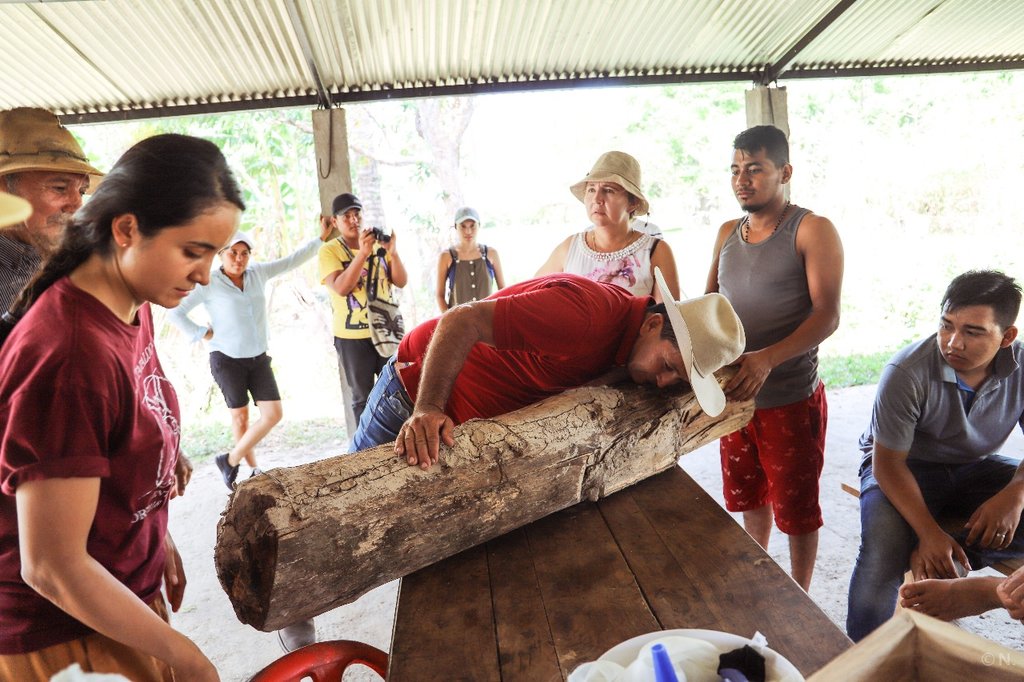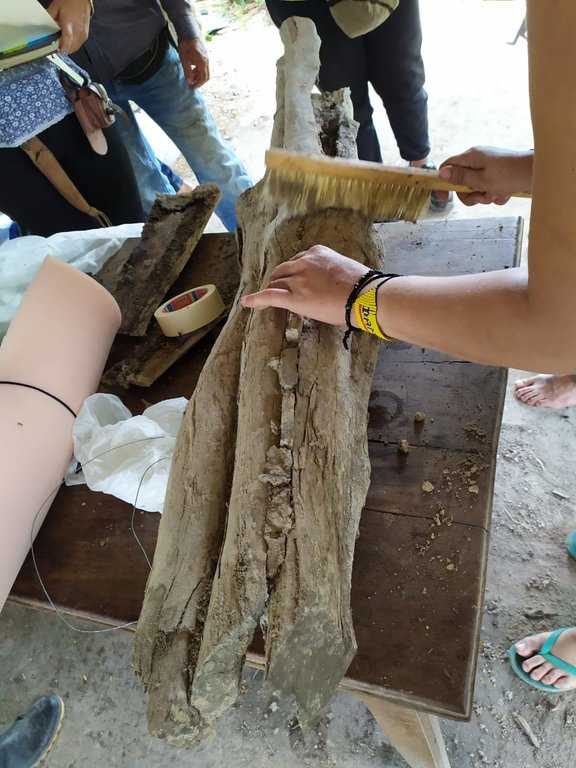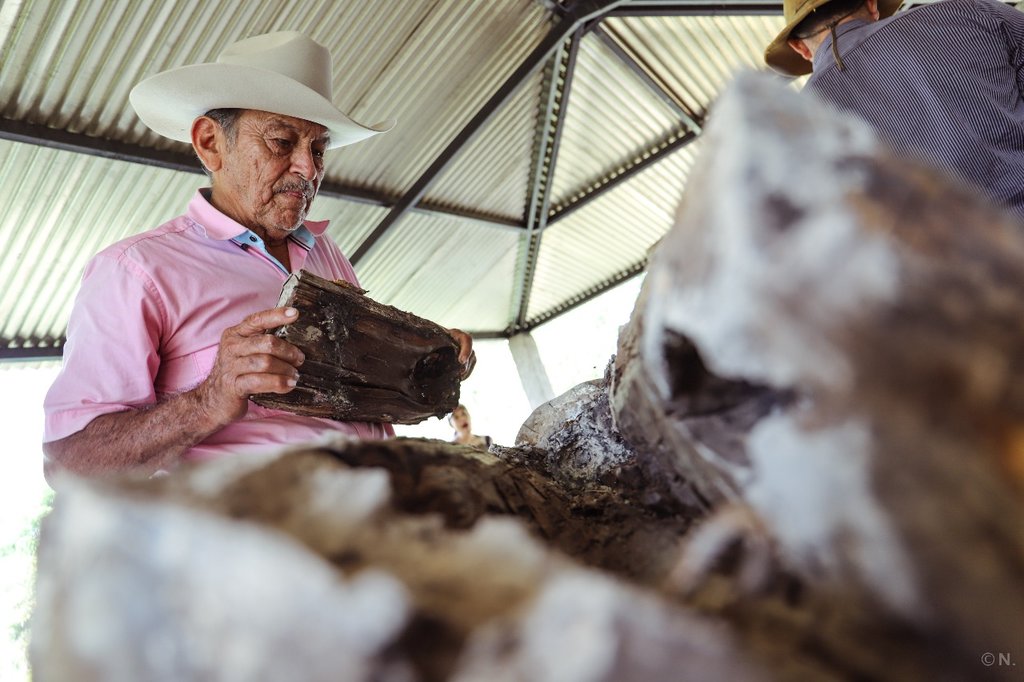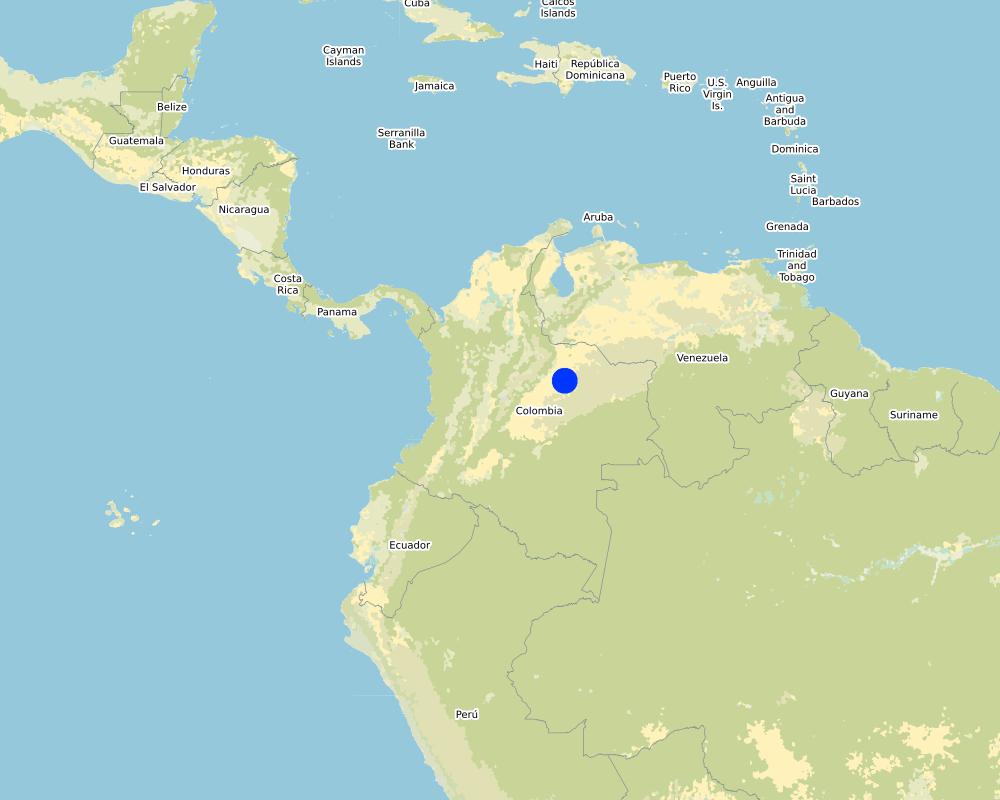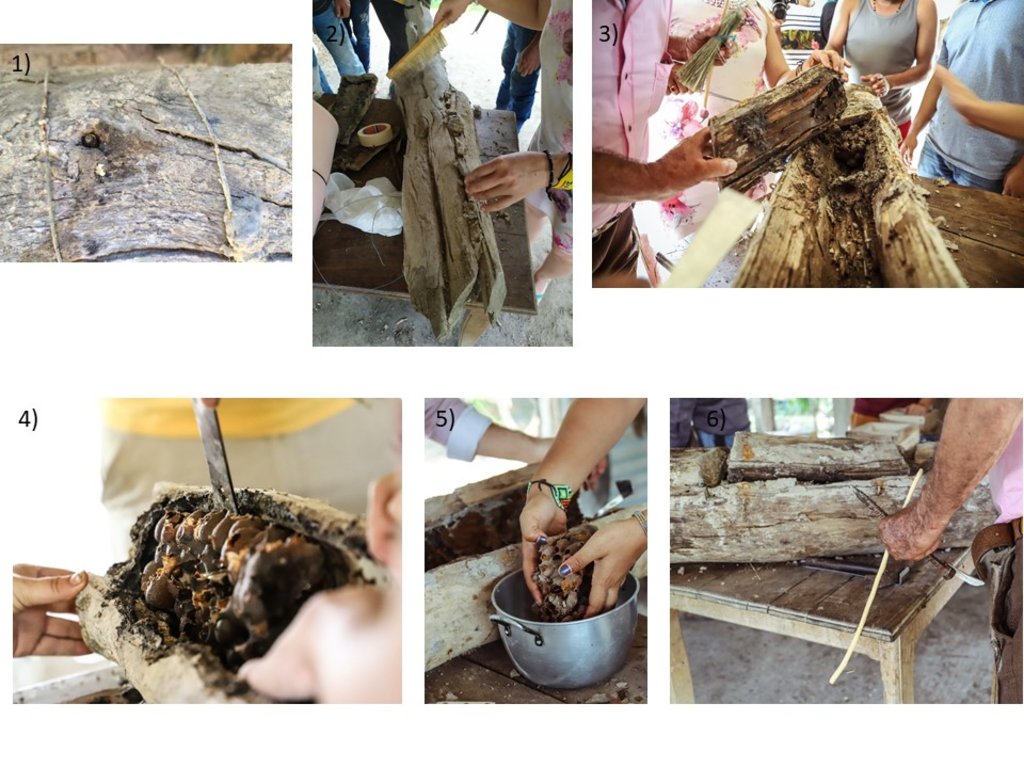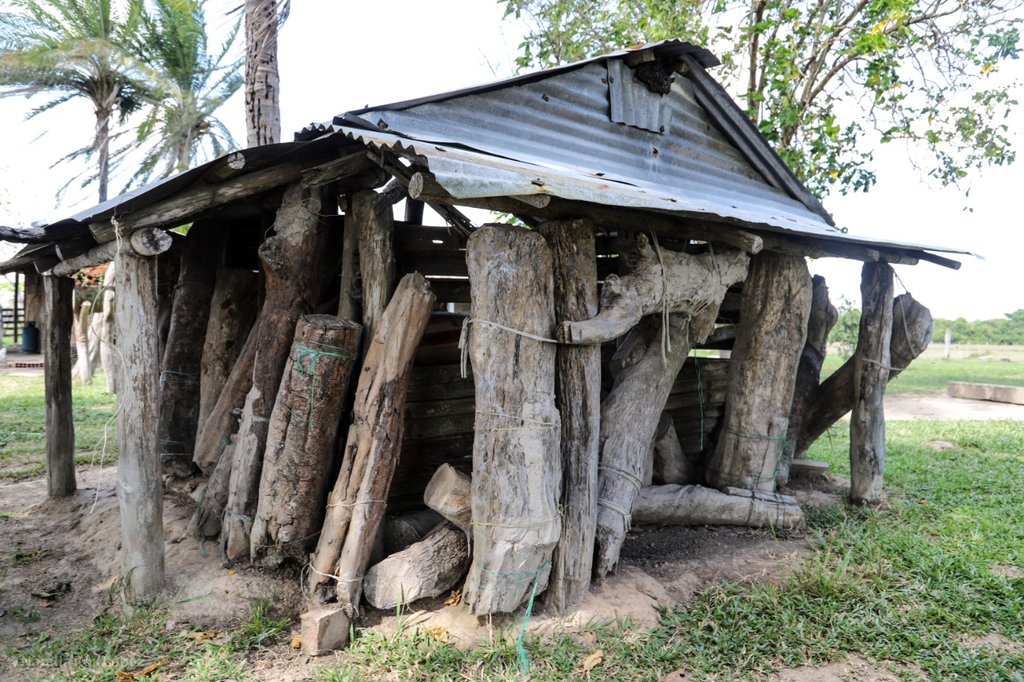Sustainable traditional native bee (Melipona favosa) keeping [Colombie]
- Création :
- Mise à jour :
- Compilateur : Beatriz Ramirez
- Rédacteur : Luisa F. Vega
- Examinateur : Hanspeter Liniger
Cría de abeja mancita
technologies_5797 - Colombie
Voir les sections
Développer tout Réduire tout1. Informations générales
1.2 Coordonnées des personnes-ressources et des institutions impliquées dans l'évaluation et la documentation de la Technologie
Personne(s)-ressource(s) clé(s)
exploitant des terres:
Abril Héctor
Finca La Reforma
Colombie
exploitant des terres:
Abril Héctor Frugo
Finca La Corocora
Colombie
exploitant des terres:
Abril Damaris
Finca La Esmeralda
Colombie
exploitant des terres:
Abril Boncieth
Finca Arbolitos
Colombie
exploitant des terres:
Abril Héctor Daniel
Finca La Berraquera
Colombie
Nom du ou des institutions qui ont facilité la documentation/ l'évaluation de la Technologie (si pertinent)
Centro de Estudios Ambientales de la Orinoquia- Asociación de Becarios de Casanare (ABC) - Colombie1.3 Conditions relatives à l'utilisation par WOCAT des données documentées
Le compilateur et la(les) personne(s) ressource(s) acceptent les conditions relatives à l'utilisation par WOCAT des données documentées:
Oui
1.4 Déclaration sur la durabilité de la Technologie décrite
Est-ce que la Technologie décrite ici pose problème par rapport à la dégradation des terres, de telle sorte qu'elle ne peut pas être déclarée comme étant une technologie de gestion durable des terres?
Non
2. Description de la Technologie de GDT
2.1 Courte description de la Technologie
Définition de la Technologie:
Native stingless bee keeping (Melipona favosa) protects bees and plants found in forest and savannah ecosystems to produce honey. In contrast to current destructive wild bee honey harvesting, members of the Abril family keep the traditional practice of capturing/rescuing wild nests, and adapt them so that honey can be extracted from the same nest for many years (up to 30 y) without killing the bees.
2.2 Description détaillée de la Technologie
Description:
Native bee honey production in the floodable savannahs of the eastern Colombian Llanos (Orinoco River Basin), relies on stingless bees of the species Melipona favosa. These bees nest inside tree trunks. The main characteristics of the native bee keeping, as currently performed by three generations of the Abril Family, is that it is sustainable, promotes de conservation of native ecosystems, and as far as we know, constitutes the only sustainable and profitable direct use of local biodiversity in the floodable savannahs of the eastern Llanos in Colombia. Its sustainability is due to the adaptations and management of the nests, so that honey can be extracted without damaging the bees. On one hand, they know how to retrieve wild nests, either by rescuing them from rotten trees or the ground, or by cutting the branch with the nest, and then keeping its natural position at all times. Once at their houses, they will study the outside of the nest and listen to the bees inside the nest, with this information they will cut out a part of the tree trunk to create a window. Once opened, they verify the location of the honey and pollen pots and the broods. Then, they will reattach the cut part on to the trunk by using metal wire and sealing the edges with mud. The nest will be hanged with wire in the position it was originally found. Once on site they will check every day for the presence of the sentinel bee and bee activity. Furthermore, they only extract honey during the end of the dry season when bees have enough food reserves. For the extraction, they will reopen the previously cut window, and extract the honey and pollen pots, making sure enough are left behind so that bees can have access to food as well. The mean honey production from each nest is around the 750 ml- 1000 ml. Honey is kept for their own use and sold to some people for a fairly high price (30 dollars per 750 ml). The honey is mainly consumed as a medicinal product, and its low quantity makes it highly sought after. If someone requests it for sight issues, Héctor will extract the honey with a syringe so that it is as clear as possible.
The native bee keeping contributes to protect native bees, as the management of nests can keep them functional for up to 30 years. The Abril family members are well aware of the dependency between honey production and presence of native plants from where bees forage for nectar and pollen. Therefore, they avoid forest clearing and selectively keep shrubs in the grasslands to guarantee food supply for their bees. Also, they plant fruit trees such as guayaba (Psidium guajava) and arazá (Eugenia stipitata), that benefit the bees, which at the same time benefit pollination. Fruit production is mainly used for home use and very seldom they are sold. They also witness the negative impacts that agrochemical airborne dispersion from rice production in the neighbouring farms, have on wild bee populations. So far, their main concern is that they do not know how to multiply the nests.
2.3 Photos de la Technologie
2.4 Vidéos de la Technologie
Commentaire, brève description:
They are harvesting the honey from the pots throught the window, without affecting the brooding area. https://youtu.be/ZS_TbwV3fnw
Date:
30/01/2020
Lieu:
Finca La Reforma, Vereda Los chochos, Municipality: Trinidad, Department: Casanare, Colombia
Nom du vidéaste:
Mildred Sossa
2.5 Pays/ région/ lieux où la Technologie a été appliquée et qui sont couverts par cette évaluation
Pays:
Colombie
Région/ Etat/ Province:
Casanare
Autres spécifications du lieu:
Municipality: Trinidad, Vereda: Los Chochos
Spécifiez la diffusion de la Technologie:
- appliquée en des points spécifiques ou concentrée sur une petite surface
Est-ce que les sites dans lesquels la Technologie est appliquée sont situés dans des zones protégées en permanence?
Non
Commentaires:
All farms are neighbors and they all belong to the Abril family members (Father, two sons and a daughter)
Map
×2.6 Date de mise en œuvre de la Technologie
Si l'année précise est inconnue, indiquez la date approximative: :
- il y a entre 10-50 ans
2.7 Introduction de la Technologie
Spécifiez comment la Technologie a été introduite: :
- dans le cadre d'un système traditionnel (> 50 ans)
Commentaires (type de projet, etc.) :
Héctor Abril, has been working with this traditional systems since more than 50 years ago. The traditional system consists in creating a window implied o extract honey without damaging the nest. This knowledge has been passed on to his sons and daughter.
3. Classification de la Technologie de GDT
3.1 Principal(aux) objectif(s) de la Technologie
- améliorer la production
- préserver l'écosystème
- conserver/ améliorer la biodiversité
- créer un impact économique positif
3.2 Type(s) actuel(s) d'utilisation des terres, là où la Technologie est appliquée
Les divers types d'utilisation des terres au sein du même unité de terrain: :
Non

Pâturages
Pâturage extensif:
- Ranching
Type d'animal:
- bétail - bovins à viande
Est-ce que la gestion intégrée cultures-élevage est pratiquée?
Non
Produits et services:
- viande
Espèces:
bétail - bovins à viande
Nombre:
150
Espèces:
beekeeping, apiculture
Nombre:
80

Forêts/ bois
- Forêts (semi-)naturelles/ bois
Forêts (semi-)naturelles/ terres boisées: précisez le mode de gestion:
- Coupes sélectives
- Utilisation de la forêt non liée au bois
Type de forêts (semi)-naturelles:
- végétation naturelle des forêts tropicales humides de feuillus
- végétation naturelle des zones arbustives tropicales
- Natural strips of gallery forest along savannah's rivers
Commentaires:
The main economic activity of this group of farms is extensive cattle ranching on natural floodable savannhas (242 ha), but they all have bee keeping in their houses. The number 80 refers to the nest quantity. They preserve gallery forests (108 ha) and allow for fallows (28 ha) to develope near the houses for supplying nectar and pollen to the bees.
3.3 Est-ce que l’utilisation des terres a changé en raison de la mise en œuvre de la Technologie ?
Est-ce que l’utilisation des terres a changé en raison de la mise en œuvre de la Technologie ?
- Oui (Veuillez remplir les questions ci-après au regard de l’utilisation des terres avant la mise en œuvre de la Technologie)
Les divers types d'utilisation des terres au sein du même unité de terrain: :
Non

Forêts/ bois
- Forêts (semi-)naturelles/ bois
Forêts (semi-)naturelles/ terres boisées: précisez le mode de gestion:
- Utilisation de la forêt non liée au bois
Type de forêts (semi)-naturelles:
- végétation naturelle des forêts tropicales humides de feuillus
- végétation naturelle des zones arbustives tropicales
Commentaires:
The fact that their traditional practice allow for them to keep the bee nests in their houses for up to 30 years, means that they had to protect surrounding forests and allow for shrubland recovery nearby the house. Otherwise, they would just either collect honey directly in the field in a single destructive event or bring a couple of nests per year home and then extract honey in a destructive way.
3.4 Approvisionnement en eau
Approvisionnement en eau des terres sur lesquelles est appliquée la Technologie:
- pluvial
Commentaires:
The farms have some windmills for water extraction for the cattle ranching, but these are not used for the natural ecosystems that sustain the bees during the dry season.
3.5 Groupe de GDT auquel appartient la Technologie
- apiculture, aquaculture, élevage de volailles, de lapins, du ver à soie, etc.
3.6 Mesures de GDT constituant la Technologie

pratiques végétales
- V1: Couverture d’arbres et d’arbustes

modes de gestion
- M1: Changement du type d’utilisation des terres
Commentaires:
Bee keeping implies supplying the bees nectar and polen demands, thus, for sustaining their bees the Abril family is particularly keen on protecting their gallery forests and allow shrub regeneration. In addition, they are cultivating fruit trees (guayaba- Psidium guajava; arazá- Eugenia stipitata) near the houses, impplying a change in land cover from grazing land to fruit crops.
3.7 Principaux types de dégradation des terres traités par la Technologie

érosion hydrique des sols
- Wt: perte de la couche superficielle des sols (couche arable)/ érosion de surface

érosion éolienne des sols
- Et: perte de la couche superficielle des sols (couche arable)

dégradation physique des sols
- Pc: compaction

dégradation biologique
- Bh: perte d’habitats
- Bs: baisse de la qualité et de la composition/ diversité des espèces
Commentaires:
Forest conservation and shrub recovery and fruit crops aid in the reduction of erosion by water during the wet season, and erosion by wind during the dry season. Forest conservation and shrub recovery and fruit crops reduce areas exposed to cattle trampling. Forest conservation, shrub recovery and fruit crops are likely important to protect soil fauna, to enhance the survival of bees and many other animal and plant species. A high density of pollinators is also important for natural vegetation and fruitting crop
3.8 Prévention, réduction de la dégradation ou réhabilitation des terres dégradées
Spécifiez l'objectif de la Technologie au regard de la dégradation des terres:
- prévenir la dégradation des terres
Commentaires:
On the one hand, they actively preserve the riparian forests because of their awareness of the relation between bee survival and honey production with forest cover. This reduces land degradation. On the other hand, surrounding their houses where they keep the bees they have planted trees and allowed for fallow areas to offer pollen and nectar to their bees, restoring land that has been previously used for cattle ranching
4. Spécifications techniques, activités, intrants et coûts de mise en œuvre
4.1 Dessin technique de la Technologie
Spécifications techniques (associées au dessin technique):
This is too complex to draw, so we presented the sequence of extracting honey in a nest that has been modified so that the nest can live up to 30 years.
Auteur:
Natalia Roa y Beatriz Ramírez
Date:
30/01/2020
Spécifications techniques (associées au dessin technique):
This is the housing for the nests. These nests have been collected or rescued from field. The youngest has 3 years the oldest has around 30 years. It is very important to keep the nests in the position they were originally found. The housing is to prevent direct sunshine and rainfall exposition.
Auteur:
Natalia Roa
Date:
30/01/2020
4.2 Informations générales sur le calcul des intrants et des coûts
Spécifiez la manière dont les coûts et les intrants ont été calculés:
- par entité de la Technologie
Précisez l'unité:
bee nest
Indiquez la monnaie utilisée pour le calcul des coûts:
- dollars américains
Indiquez le coût salarial moyen de la main d'œuvre par jour:
$ 15
4.3 Activités de mise en place/ d'établissement
| Activité | Calendrier des activités (saisonnier) | |
|---|---|---|
| 1. | Wild nest recue or extraction and transport to the house | Depends on the finding, but it is preferred in the dry season where more floral resources are available |
| 2. | Opening of a window in the nest | A couple of days after being collected/recued |
| 3. | Locating the nest under housing | Just after the window opening |
4.4 Coûts et intrants nécessaires à la mise en place
| Spécifiez les intrants | Unité | Quantité | Coûts par unité | Coût total par intrant | % des coût supporté par les exploitants des terres | |
|---|---|---|---|---|---|---|
| Main d'œuvre | Two people for wild nest recue or extraction and transport to the house | day | 2,0 | 15,0 | 30,0 | 100,0 |
| Main d'œuvre | Opening of a window in the nest | day | 0,5 | 15,0 | 7,5 | 100,0 |
| Main d'œuvre | Housing construction (two people) | day | 2,0 | 15,0 | 30,0 | 100,0 |
| Main d'œuvre | 100,0 | |||||
| Equipements | Saw | unit | 1,0 | 20,0 | 20,0 | 100,0 |
| Equipements | Chissel | unit | 1,0 | 10,0 | 10,0 | 100,0 |
| Equipements | hammer | unit | 1,0 | 8,0 | 8,0 | 100,0 |
| Equipements | Metal wire | kilo | 0,5 | 11,0 | 5,5 | 100,0 |
| Equipements | Ax | unit | 1,0 | 20,0 | 20,0 | 100,0 |
| Matériaux de construction | boles minimum 15 cm diamater and 2 m of height | boles | 4,0 | 8,0 | 32,0 | 100,0 |
| Matériaux de construction | wood support 4 m long | unit | 4,0 | 6,0 | 24,0 | 100,0 |
| Matériaux de construction | Roof laminas (3 m) | laminas | 3,0 | 18,0 | 54,0 | 100,0 |
| Matériaux de construction | Nails | box | 2,0 | 9,0 | 18,0 | 100,0 |
| Coût total de mise en place de la Technologie | 259,0 | |||||
| Coût total de mise en place de la Technologie en dollars américains (USD) | 259,0 | |||||
Commentaires:
The construction of a bee nest house can hold up to 30 bee nests.
4.5 Activités d'entretien/ récurrentes
| Activité | Calendrier/ fréquence | |
|---|---|---|
| 1. | Checking the bee nests | daily |
| 2. | Harvesting honey | yearly |
| 3. | Seedling collection | monthly |
| 4. | tree nursery care | daily |
| 5. | planting trees | monthly |
4.6 Coûts et intrants nécessaires aux activités d'entretien/ récurrentes (par an)
| Spécifiez les intrants | Unité | Quantité | Coûts par unité | Coût total par intrant | % des coût supporté par les exploitants des terres | |
|---|---|---|---|---|---|---|
| Main d'œuvre | Daily check per bee nest | day | 0,005 | 15,0 | 0,07 | 100,0 |
| Main d'œuvre | honey harvest per bee nest (2 people) | day | 1,0 | 15,0 | 15,0 | 100,0 |
| Main d'œuvre | Seedling collection | month | 2,0 | 15,0 | 30,0 | 100,0 |
| Main d'œuvre | Planting of fruitting trees | month | 2,0 | 15,0 | 30,0 | 100,0 |
| Equipements | Chissel | unit | 1,0 | 10,0 | 10,0 | 100,0 |
| Equipements | Broom | unit | 1,0 | 3,0 | 3,0 | 100,0 |
| Equipements | Hammer | unit | 1,0 | 8,0 | 8,0 | 100,0 |
| Equipements | Syringe | unit | 1,0 | 0,2 | 0,2 | 100,0 |
| Equipements | Empty glass bottles (750 ml) | unit | 70,0 | 0,4 | 28,0 | 100,0 |
| Equipements | Table | unit | 1,0 | 30,0 | 30,0 | 100,0 |
| Equipements | shovel | unit | 1,0 | 20,0 | 20,0 | 100,0 |
| Matériel végétal | Bags x 50 units | bag | 1,0 | 5,0 | 5,0 | 100,0 |
| Matériel végétal | Soil | sack | 4,0 | 6,0 | 24,0 | 100,0 |
| Coût total d'entretien de la Technologie | 203,27 | |||||
| Coût total d'entretien de la Technologie en dollars américains (USD) | 203,27 | |||||
4.7 Facteurs les plus importants affectant les coûts
Décrivez les facteurs les plus importants affectant les coûts :
The way they manage the bee productive system is fairly cheap and most materials are already accessible within the farms.
5. Environnement naturel et humain
5.1 Climat
Précipitations annuelles
- < 250 mm
- 251-500 mm
- 501-750 mm
- 751-1000 mm
- 1001-1500 mm
- 1501-2000 mm
- 2001-3000 mm
- 3001-4000 mm
- > 4000 mm
Spécifiez la pluviométrie moyenne annuelle (si connue), en mm:
1938,00
Spécifications/ commentaires sur les précipitations:
highly monomodal seasonal rainfall with 4 months without rainfall (< 60 mm/ month), and 8 months with rainfall (>100 mm/ month) with June as the month with highest rainfall (> 300 mm)
Indiquez le nom de la station météorologique de référence considérée:
Estación pluviométrica de Trinidad (IDEAM)
Zone agro-climatique
- subhumide
The highly seasonal rainfall, implies four months of extreme drought and at least 6 months of flooded areas. Both severely limit crop growth.
5.2 Topographie
Pentes moyennes:
- plat (0-2 %)
- faible (3-5%)
- modéré (6-10%)
- onduleux (11-15%)
- vallonné (16-30%)
- raide (31-60%)
- très raide (>60%)
Reliefs:
- plateaux/ plaines
- crêtes
- flancs/ pentes de montagne
- flancs/ pentes de colline
- piémonts/ glacis (bas de pente)
- fonds de vallée/bas-fonds
Zones altitudinales:
- 0-100 m
- 101-500 m
- 501-1000 m
- 1001-1500 m
- 1501-2000 m
- 2001-2500 m
- 2501-3000 m
- 3001-4000 m
- > 4000 m
Indiquez si la Technologie est spécifiquement appliquée dans des:
- non pertinent
Commentaires et précisions supplémentaires sur la topographie:
This is a low elevation flat area. Overall the floodable savannahs are concave but microtopography has primarily concave areas (bajos) with a lower extent of convex areas (bancos).
5.3 Sols
Profondeur moyenne du sol:
- très superficiel (0-20 cm)
- superficiel (21-50 cm)
- modérément profond (51-80 cm)
- profond (81-120 cm)
- très profond (>120 cm)
Texture du sol (de la couche arable):
- moyen (limoneux)
Texture du sol (> 20 cm sous la surface):
- moyen (limoneux)
- fin/ lourd (argile)
Matière organique de la couche arable:
- faible (<1%)
Si disponible, joignez une description complète du sol ou précisez les informations disponibles, par ex., type de sol, pH/ acidité du sol, capacité d'échange cationique, azote, salinité, etc.
In the seasonally floodable savannhas there are three main soil types: 1) Clayey sediments, 2) fine and coarse alluvial sediments, and 3) lime and sand eolic deposits. Soil description is based on the 1:100.000 scale Casanare soil study, by the National Geographical Institute Agustín Codazzi.
5.4 Disponibilité et qualité de l'eau
Disponibilité de l’eau de surface:
moyenne
Qualité de l’eau (non traitée):
faiblement potable (traitement nécessaire)
La salinité de l'eau est-elle un problème? :
Non
La zone est-elle inondée?
Oui
Régularité:
fréquemment
Commentaires et précisions supplémentaires sur la qualité et la quantité d'eau:
Drinking water is usually provided by ground water year round. During the wet season there is a generalized flood, and during the dry season there is severe drought. Thus, the water table level goes from surface to deeper than 9 m.
5.5 Biodiversité
Diversité des espèces:
- élevé
Diversité des habitats:
- élevé
Commentaires et précisions supplémentaires sur la biodiversité:
Habitats include: Gallery/riparian forest, isolated tree islands (matas de monte), seasonally flooded savannhas, wetlands.
Reported biodiversity for the seasonally floodable savannahs is: 183 spp of mammals, 507 spp of birds, 108 spp of anphibians, 119 spp of reptiles, 567 spp of fish, 1479 spp of plants (Mora-Fernández et al., 2015).
5.6 Caractéristiques des exploitants des terres appliquant la Technologie
Sédentaire ou nomade:
- Sédentaire
Orientation du système de production:
- exploitation mixte (de subsistance/ commerciale)
Revenus hors exploitation:
- moins de 10% de tous les revenus
Niveau relatif de richesse:
- pauvre
Individus ou groupes:
- individu/ ménage
Niveau de mécanisation:
- travail manuel
- traction animale
Genre:
- femmes
- hommes
Age des exploitants des terres:
- personnes d'âge moyen
- personnes âgées
Indiquez toute autre caractéristique pertinente des exploitants des terres:
All the land user's reported here are family members.
5.7 Superficie moyenne des terres utilisées par les exploitants des terres appliquant la Technologie
- < 0,5 ha
- 0,5-1 ha
- 1-2 ha
- 2-5 ha
- 5-15 ha
- 15-50 ha
- 50-100 ha
- 100-500 ha
- 500-1 000 ha
- 1 000-10 000 ha
- > 10 000 ha
Cette superficie est-elle considérée comme de petite, moyenne ou grande dimension (en se référant au contexte local)?
- petite dimension
- moyenne dimension
Commentaires:
For the area 30 ha farms are very small, whereas 200 ha is small-medium. This is considering that farms in this region of colombia have on average 700 ha.
5.8 Propriété foncière, droits d’utilisation des terres et de l'eau
Propriété foncière:
- individu, sans titre de propriété
Droits d’utilisation des terres:
- individuel
Droits d’utilisation de l’eau:
- individuel
Est-ce que les droits d'utilisation des terres sont fondés sur un système juridique traditionnel?
Oui
Précisez:
They are in the process of gaining rights, given the farms have been theirs for more than 50 years.
5.9 Accès aux services et aux infrastructures
santé:
- pauvre
- modéré
- bonne
éducation:
- pauvre
- modéré
- bonne
assistance technique:
- pauvre
- modéré
- bonne
emploi (par ex. hors exploitation):
- pauvre
- modéré
- bonne
marchés:
- pauvre
- modéré
- bonne
énergie:
- pauvre
- modéré
- bonne
routes et transports:
- pauvre
- modéré
- bonne
eau potable et assainissement:
- pauvre
- modéré
- bonne
services financiers:
- pauvre
- modéré
- bonne
Commentaires:
These farms are in fairly remote area with poor access roads, there is a rural school but for the other services people have to travel for at least 2 hours by car to the closest urban center.
6. Impacts et conclusions
6.1 Impacts sur site que la Technologie a montrés
Impacts socio-économiques
Production
production forestière non ligneuse
Commentaires/ spécifiez:
Honey harvesting from collected bee nests
Revenus et coûts
revenus agricoles
Commentaires/ spécifiez:
Honey harvesting contributes with about 10% of farm income
diversité des sources de revenus
Commentaires/ spécifiez:
Honey harvesting is an additional income source from cattle ranching
Impacts socioculturels
sécurité alimentaire/ autosuffisance
Commentaires/ spécifiez:
Part of the honey and most of the fruits harvested are consumed by the land user theirself.
Impacts écologiques
Biodiversité: végétale, animale
espèces bénéfiques
Commentaires/ spécifiez:
The preservation of bee nests increases pollinator presence, whilst the conservation of gallery forests preserves habitats for wild bee populations.
diversité des habitats
Commentaires/ spécifiez:
allowing for fallows to regenerate for providing bees with resources (nectar, pollen, resins and seeds) increase habitat diversity.
Précisez l'évaluation des impacts sur site (sous forme de mesures):
Measurements are qualitative estimates
6.2 Impacts hors site que la Technologie a montrés
capacité tampon/de filtration
Commentaires/ spécifiez:
Riparian forest conservation contributed to water regulation
Précisez l'évaluation des impacts extérieurs (sous forme de mesures):
Measurements are qualitative estimates
6.3 Exposition et sensibilité de la Technologie aux changements progressifs et aux évènements extrêmes/catastrophes liés au climat (telles que perçues par les exploitants des terres)
Extrêmes climatiques (catastrophes)
Catastrophes biologiques
| Comment la Technologie fait-elle face à cela? | |
|---|---|
| maladies épidémiques | pas bien |
6.4 Analyse coûts-bénéfices
Quels sont les bénéfices comparativement aux coûts de mise en place (du point de vue des exploitants des terres)?
Rentabilité à court terme:
légèrement positive
Rentabilité à long terme:
très positive
Quels sont les bénéfices comparativement aux coûts d'entretien récurrents (du point de vue des exploitants des terres)?
Rentabilité à court terme:
légèrement positive
Rentabilité à long terme:
très positive
Commentaires:
Honey harvesting is only possible once per year so for the short term it takes some time before retrieving income. However, once the nests are re-established at home the maintenance is fairly easy. The rareness and uniqueness of the product sells well in the local market. The external markets are not aware of such a product.
6.5 Adoption de la Technologie
- cas isolés/ expérimentaux
Si disponible, quantifiez (nombre de ménages et/ou superficie couverte):
5
De tous ceux qui ont adopté la Technologie, combien d'entre eux l'ont fait spontanément, à savoir sans recevoir aucune incitation matérielle, ou aucune rémunération? :
- 91-100%
Commentaires:
Talking with other local people we found that the traditional practice is very rare, mainly because it used to be the only source for sweeteners, but with the arrival of sugar cane and sugar, people stopped the practice, and for new generations the tradicional way is almost forgotten. This is highly menacing because when people find a wild nest they only destructively extract the honey affecting wild bee populations.
6.6 Adaptation
La Technologie a-t-elle été récemment modifiée pour s'adapter à l'évolution des conditions?
Non
6.7 Points forts/ avantages/ possibilités de la Technologie
| Points forts/ avantages/ possibilités du point de vue de l'exploitant des terres |
|---|
| The medicinal properties attributed to the product make it highly sought after. |
| Having the nests at home, and passing on the traditional practice to new generations is very important, because they find very interesting to know about bee behaviour and pollination function for fruitting trees. |
| Costs are fairly low, and despite production is synchronized the demand of the product is higher that the production, so it is a welcome income to the family household assets. |
| Points forts/ avantages/ possibilités du point de vue du compilateur ou d'une autre personne ressource clé |
|---|
| Their practice is non destructive and bee population is enhanced in the houses, it is very likely that bees will find new wild nesting sites. In this regard bee nests at houses are a source of individuals for wild populations, given that there are trees and forests nearby. |
| This practice and their knwoledge on bee behaviour and biology motivates people to conserve forests and trees and allow for fallows surrounding their houses. |
| Negative effects on their bee populations derived from land use change int heir surroundings and application of agrochemicals by neighboring rice crops serve as an indicator for them to know if those practices are deteriorating their environment. |
6.8 Faiblesses/ inconvénients/ risques de la Technologie et moyens de les surmonter
| Faiblesses/ inconvénients/ risques du point de vue de l’exploitant des terres | Comment peuvent-ils être surmontés? |
|---|---|
| Despite the long term survival of captured wil bee nests, they still rely on collecting wild nests. Which in time they feel are more scarcee | For them it is crucial to learn how to split their "domesticated" nests so they can increase production without depending on wild nests. |
| The expansion of rice crops in the area is a major threat | Public policy and law inforcement in aerial agrochemical application is urgent. Also, the transition from usual rice crop management to a more enrionmental management is required. |
| New generations are less likely to adopt traditional practices, endengering the persistence of this knowledge in time | The recognition of this traditional productive system is fundamental. |
| Faiblesses/ inconvénients/ risques du point de vue du compilateur ou d'une autre personne ressource clé | Comment peuvent-ils être surmontés? |
|---|---|
| A one time per year harvesting of the product could potentially be increased to expand this sustainable practice | Restoration of key dietary elements surrounding their houses and an increase in connectivity with remaingin forest patches could potentially increase honey production |
| We agree that the loss of this practice is inminent if it is not protected as a cultural heritage | Knwoledge transfer to new generations and the recovery of this productive system, once "domesticated" bee nest can be divided or multiplied. |
7. Références et liens
7.1 Méthodes/ sources d'information
- visites de terrain, enquêtes sur le terrain
4
- interviews/entretiens avec les exploitants des terres
4
Quand les données ont-elles été compilées (sur le terrain)?
30/01/2020
Commentaires:
Land-users were very pleased with the recognition of the their prodcutive systems and were very happy to contribute us to understand how it works.
7.3 Liens vers les informations pertinentes en ligne
Titre/ description:
Diversidad de abejas sin aguijón (Hymenoptera: Meliponini) utilizadas en meliponicultura en Colombia. Nates-Parra, G. and Rosso-Londoño, J.M. (2013).
URL:
https://www.redalyc.org/pdf/3190/319029232001.pdf
7.4 Observations d'ordre général
It is a bit too long but feasible to fill in.
Liens et modules
Développer tout Réduire toutLiens
Aucun lien
Modules
Aucun module trouvé


